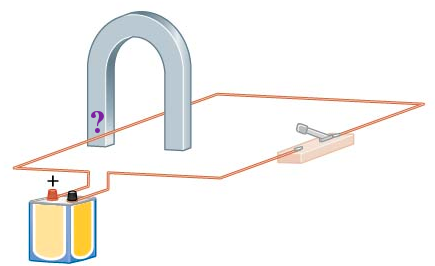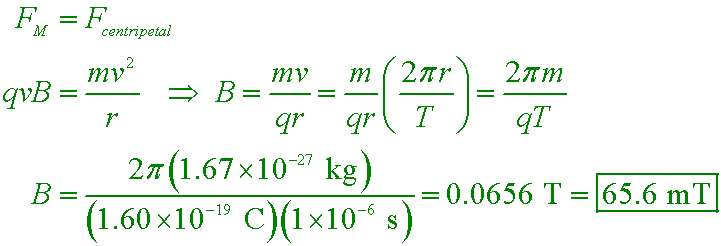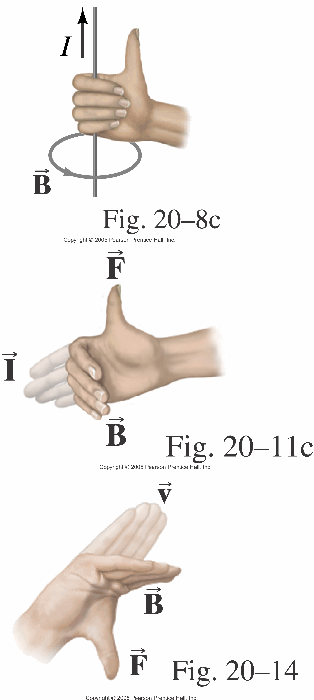Summary
- Magnets
- Magnetic fields
- Currents produce magnetic fields

About the photo
Lecture learning outcomes
A student who masters the topics in this lecture will be able to:
- use the appropriate right-hand rule to predict the direction of the magnetic force exerted on a charged particle that moves in a region of magnetic field
- use algebra to find the magnetic force F, current I, length L, magnetic field B, or angle θ when any four of these quantities are given
- use algebra to find the magnetic force F, charge q, velocity v, magnetic field B, or angle θ when any four of these quantities are given
- explain the helical motion of a charged particle that moves in a uniform magnetic field
Practice:
Try these additional examples
Example #3
Example #4
Prepare:
Read textbook sections 22-6 and 22-7 before the next lecture
gc6 20.5
The force on a wire carrying 8.75 A is a maximum of 1.28 N when placed between the pole faces
of a magnet that are 55.5 cm in diameter. What is the approximate strength of the magnetic field?
A. 1.28 T
B. 0.875 T
C. 0.379 T
D. 0.264 T
Answer
sj6 29.34
A proton moving in a circular path has a period of 1.00 µs. What is B?
A. 1.00 µT
B. 55.2 µT
C. 33.3 mT
D. 65.6 mT
Answer
sj6 29.8
If B = 50 µT northward and E=100 N/C downward, how do the force magnitudes on an
electron with velocity 6000 km/s eastward compare?
A. gravity > electric > magnetic
B. electric > gravity > magnetic
C. magnetic > electric > gravity
D. electric > magnetic > gravity
Answer
Walker5e CnEx 22-12
When the switch is closed the wire between the poles of the horseshoe magnet deflects downward. Is the left end of the magnet a north magnetic pole or a south magnetic pole?

A. north
B. south
C. either pole produces a downward deflection
Answer
D. 0.264 T

D. 65.6 mT

C. magnetic > electric > gravity


A. north
Using the right-hand-rule, if your thumb points downward (the direction of the force) your fingers curl toward the right (the direction of the magnetic field). Magnetic fields come out of the north pole and enter the south pole of a magnet.
The photo above depicts aurora loops around the southern
polar region in the distance as viewed by astronauts onboard the space shuttle Discovery on STS-39 in 1991.
Aurora are formed at the poles of the earth where charged particles
from the sun spiral around the magnetic fields of the earth and slam into the atmosphere, ionizing the
gas molecules and causing them to emit light.
Source: NASA Image Exchange

Red and green colors predominate in this view of the Aurora Australis
photographed from the Space Shuttle in May 1991 at the peak of a geomagnetic maximum.
Source: NASA Earth Observatory

Here is another photograph of the southern lights taken by astronauts onboard the Space Shuttle Discovery. The
emissions, extending nearly vertically upward, trace out the Earth's magnetic field lines. The green glow occurs
at altitudes near 80-120 kilometers. The red glow is less energetic and occurs at altitude above 250 kilometers.
Both types of light are produced by oxygen atoms in the atmosphere. Photos provided courtesy of NASA, Astronaut
Overmeyer and Dr. Hallinan. The source of this material is
Windows to the Universe
at the University Corporation for Atmospheric Research (UCAR). ©1995-1999, 2000
The Regents of the University of Michigan; ©2000-01 University Corporation for Atmospheric Research.
All Rights Reserved.

Here is an even better photo from the International Space Station (See a movie!)
Of course, auroras are also visible from earth!

Aurora photographed by Markus Varik on February 19, 2018 in Tromsø, Norway. From the
spaceweather.com
real-time aurora gallery

Aurora photographed by Mark Taylor on September 12, 2014 in central Maine. From
phys.org/news/2015-01-northern.html
- Blue: nitrogen 0 to 60 mi altitude
- Red: oxygen 150+ mi altitude
- Green: oxygen 60 to 150 mi altitude
- Yellow: mixture of red and green












